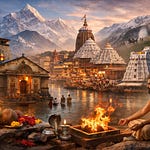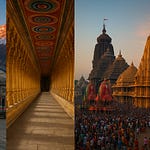Badrinath, seated in the majestic Garhwal Himalayas of Chamoli district, Uttarakhand, at an altitude of 3,133 meters (10,279 feet), is more than just a temple—it is a sacred portal where earthly existence meets divine transcendence. As one of the most visited spiritual destinations in India, it holds immense significance across cultural, mythological, and devotional spectrums. It is part of the Pan-India Char Dham Yatra—alongside Rameswaram, Dwarka, and Puri—as well as the Chhota Char Dham circuit of Uttarakhand, which includes Yamunotri, Gangotri, Kedarnath, and Badrinath. The town attracts lakhs of devotees annually and is a symbol of the Himalayan devotion-centered civilization.
The Mythical Story Behind Badrinath
The roots of Badrinath lie in the ancient Puranic and Vedic traditions. Legends say that Lord Vishnu, in his incarnation as Narayana, chose this location for intense penance. Observing his unwavering meditation in the icy winds and snow, Goddess Lakshmi is believed to have taken the form of a Badri tree (jujube or Indian date) to protect him from the elements. Hence the name "Badri-Nath" (Lord of the Badris). The Sanskrit term "Badri" refers to a berry, signifying the nurturing aspect of Lakshmi in shielding the meditating Vishnu.
Another legend tells us that Lord Shiva and Parvati once meditated in this region. When Vishnu arrived, they gracefully vacated the space in deference to his penance. The Skanda Purana mentions Badrinath as "Badarikashram," one of the holiest Vishnu shrines on Earth. These stories are more than myths—they reflect devotion as sacrifice, protection as divine feminine, and truth as eternal stillness.
Historical Background and Temple Foundation
Although its spiritual significance predates written history, the formal establishment of the Badrinath shrine is attributed to Adi Shankaracharya in the 8th century CE. During his extensive pilgrimage across India to revive Sanatana Dharma, he discovered a black Saligram (fossilized ammonite stone considered sacred to Vishnu) idol of Badrinarayan submerged in the Alaknanda River’s Narad Kund. He installed it in a cave, which evolved over time into a temple.
The modern structure is believed to have been commissioned and expanded by the Garhwal kings in the 16th century, including King Ajay Pal of Garhwal. Later restorations were carried out after the 1803 earthquake, particularly under British and Maratha influence. Today, the temple is administered by the Badri-Kedar Temple Committee, established in 1939, which ensures both religious sanctity and infrastructural upkeep for over 1 million annual pilgrims.
Architectural Brilliance and Sacred Layout
The Badrinath Temple is an architectural marvel amid Himalayan austerity. Built in the Nagara style of North Indian temple architecture, it features a conical shikhara (spire), arched windows, intricately carved stonework, and a brightly painted facade. The temple is divided into three main parts:
Garbha Griha (sanctum sanctorum): Houses the 1-meter tall black stone idol of Lord Badrinarayan seated in a meditative padmasana posture. The idol is believed to be self-manifested (swayambhu).
Darshan Mandap: Where devotees offer prayers and view rituals. It also holds smaller idols of Nar-Narayana, Garuda, Uddhava, Kubera, and Lakshmi.
Sabha Mandap: A pillared hall for congregational prayers and recitations. During winter, the idol is ceremonially shifted to Narsingh Temple in Joshimath due to heavy snowfall.
Surrounding the temple are thermal springs, tirths, and glacier-fed rivers, all adding to its aura of divinity.
Rituals, Puja Vidhi, and Aarti Ceremony
Daily worship at Badrinath adheres to ancient Vaishnavite Tantric and Vedic traditions. The head priest, called the Rawal, is traditionally a Namboodiri Brahmin from Kerala, symbolizing pan-Indian unity of the faith. The Rawal does not cross the inner sanctum but directs the rituals from outside, with pujaris and assistants executing the actual ceremonies.
The Day Starts With:
Mangala Aarti (4:30 am - 5:30 am): Awakening the deity with shlokas, bell ringing, and incense.
Abhishekam and Shringar: Bathing the idol in holy water and adorning it with flowers, gold ornaments, woolen garments.
Bhog Aarti: Food offerings including kheer, dry fruits, fruits, and tulsi leaves.
Sandhya Aarti (6:00 pm onwards): The evening aarti performed with grandeur, diya lighting, conch shells, and bhajans.
Devotees also perform special pujas like Vishnu Sahasranama recitation, Satyanarayan puja, and Tulsi archana.
Religious Importance and Spiritual Significance
Badrinath holds the title of ‘Vaikuntha on Earth’—a gateway to Vishnu’s supreme abode. It is considered one of the 108 Divya Desams, the sacred Vishnu temples mentioned in Tamil Alwar saints’ hymns. It also represents the Vishnu Dham in the four sacred abodes of the Char Dham yatra.
Devotees believe that even one darshan of Badrinarayan cleanses lifetimes of karma. It is also a site where many saints like Ramanujacharya, Madhvacharya, and Tulsidas meditated. The Rig Veda mentions the Himalayas as divine abodes, and Badrinath is the spiritual epicenter of these celestial terrains.
The river Alaknanda, which flows beside the temple, is considered a sacred distributary of the Ganga herself. Bathing here before darshan is believed to purify body and soul.
Festivals and Celebrations
Festivals at Badrinath are infused with spiritual energy and cultural beauty. The main temple is open only between April/May and October/November, but during these months, numerous celebrations occur.
Akshaya Tritiya (April–May): The temple opening ceremony, often attended by thousands of devotees and religious dignitaries. The idol is reinstated after six months of winter closure.
Badri-Kedar Festival (June): A 8-day cultural event held at both Badrinath and Kedarnath, featuring devotional music, dance, and spiritual discourses.
Mata Murti Ka Mela (August–September): Commemorates the descent of River Ganga due to Mata Murti’s penance and Vishnu’s appearance on Earth. A symbolic idol of Vishnu is taken in procession.
Diwali & Bhai Dooj (October–November): Temple closure ceremony with lamps, rituals, and chanting. After this, the idol is moved to Joshimath's Narsingh Temple.
Each event draws pilgrims, artists, scholars, and spiritual seekers, creating a divine cultural mosaic.
Spiritual Music, Bhajans & Kirtans
Music is the soul of devotion at Badrinath. Hymns such as:
“Shri Badri Vishal Ki Jai”
“Om Jai Jagdish Hare”
“Govinda Damodara Madhaveti”
“Achyutam Keshavam Krishna Damodaram”
are regularly sung in the temple premises. Accompanied by mridangas, kartals, and conch shells, the air is charged with bhakti and transcendence. Local Garhwali and Kumaoni bhajans further enrich the spiritual atmosphere.
Nearby Pilgrimage Sites and Sacred Geography
Badrinath is surrounded by spiritually potent sites that amplify the pilgrim’s experience:
Tapt Kund: A natural hot water spring believed to be infused with Agni’s essence. Bathing here is mandatory before darshan.
Narad Kund: Site where Shankaracharya found the idol.
Brahma Kapal: A flat platform where rituals for ancestors (pind daan) are performed. It’s believed that ancestors attain liberation if rituals are performed here.
Mana Village: The last Indian village near the Indo-Tibet border, home to:
Vyas Gufa (where Mahabharata was composed)
Ganesh Gufa
Bheem Pul, a rock bridge across the Saraswati river
Charanpaduka: Footprints of Lord Vishnu embedded in rock.
Satopanth Lake (25 km trek): A glacier lake considered sacred to Brahma, Vishnu, and Shiva.
Travel Guide and Practical Information
The journey to Badrinath is a tapasya (penance) in itself—filled with treacherous roads, spiritual anticipation, and physical resilience.
By Air: Nearest airport is Jolly Grant Airport, Dehradun, 315 km away.
By Train: Nearest railheads are Rishikesh (295 km) and Haridwar (320 km).
By Road: Accessible via national highway up to Joshimath, and then a 45 km hilly drive to Badrinath. Regular buses and shared taxis are available from Rishikesh and Haridwar.
The best time to visit is May to June and September to October. July-August should be avoided due to monsoons and landslide risks. Accommodations include GMVN guesthouses, private hotels, ashrams, and dharamshalas.
Pilgrims are advised to:
Acclimatize properly.
Carry warm clothes, rain protection, essential medicines, and personal items.
Prepare spiritually by chanting, fasting, or reading sacred texts during travel.
The Path to Liberation
Badrinath is not just a temple—it is a journey of surrender. Every rock, stream, and breath in this region feels soaked in spiritual purity and Himalayan silence. Whether one seeks moksha, inner peace, divine darshan, or ancestral healing, Badrinath provides it all in abundance.
It represents a perfect confluence of divinity, natural majesty, and deep-rooted tradition. The yatra to Badrinath is not merely external; it is a trek within—to the sacred center of the soul where Vishnu resides eternally, in stillness and grace.










